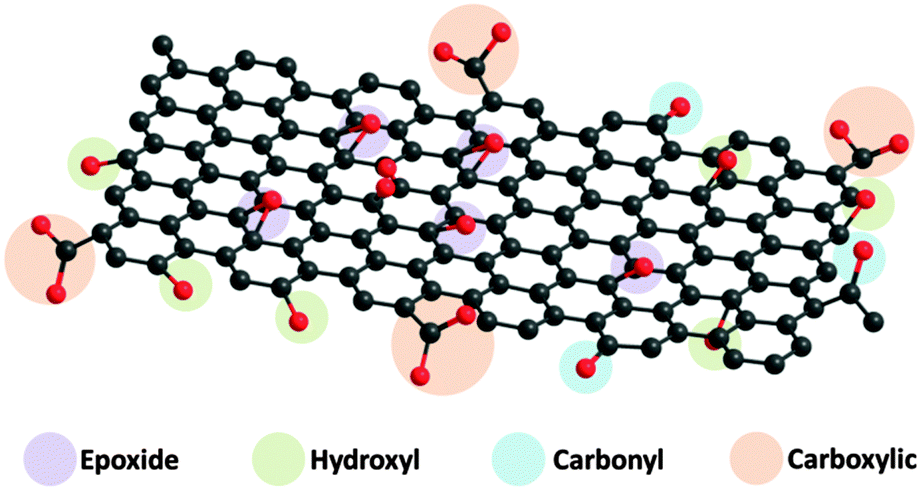
Graphene Oxide is the oxidized form of graphene. Graphene oxide (GO), the functionalized graphene recently attracted much interest thanks to its outstanding properties such as large surface area, mechanical stability, tunable electrical and optical properties. Structurally, Graphene Oxide can be visualized as a graphene sheet with its basal plane decorated by oxygen-containing groups. As graphene is expensive and relatively hard to produce, great efforts are made to find effective yet inexpensive ways to make and use graphene derivatives or related materials as people search for a simpler, more efficient and better yielding method of producing graphene, that can be scaled up massively compared to current methods, and be financially suitable for industrial or commercial applications. Graphene oxide is one of those materials - it is a single-atomic layered material, made by the powerful oxidation of graphite, which is cheap and abundant. Due to high affinity to water molecules by these groups, Graphene Oxide is hydrophilic and it is considered easy to process since it is dispersible in water (and other solvents), and it can even be used to make graphene.
Graphene oxide is not a good conductor, but its treatment by light, heat, or chemical reduction can restore most properties of pristine graphene. It is commonly sold in powder form, dispersed, or as a coating on substrates. Indeed, graphene oxide can be reduced in solution and as a thin film using a variety of reducing conditions, and reduction converts the graphene oxide into a material that has a large enhancement in electrical conductivity. Graphene oxide is one of the most popular 2D materials available. This is due to the wide range of fields that it can be applied to. Graphene oxide can easily be mixed with different polymers and other materials, and enhance properties of composite materials like tensile strength, elasticity, conductivity and more. In solid form, Graphene Oxide flakes attach one to another to form thin and stable flat structures that can be folded, wrinkled, and stretched. Such Graphene Oxide structures can be used for applications like hydrogen storage, ion conductors and nanofiltration membranes.
Graphene oxide is synthesized using four basic methods: Staudenmaier, Hofmann, Brodie and Hummers, which are mechanical or thermal exfoliation, chemical vapour deposition (CVD), and epitaxial growth. Many variations of these methods exist, with improvements constantly being explored to achieve better results and cheaper processes. The effectiveness of an oxidation process is often evaluated by the carbon/oxygen ratios of the graphene oxide. One of the most effective way of synthesised graphene on a large scale could be by the chemical reduction of graphene oxide.
Graphene oxide has a distinct advantage over other 2d materials (such as graphene), as it is easily dispersed within solution; allowing for processing at high concentrations. Owing to the expanded structural diversity and improved overall properties, graphene oxide and its composites hold great promise for versatile applications of energy storage/conversion and environment protection, including hydrogen storage materials, photocatalyst for water splitting, removal of air pollutants and water purification, as well as electrode materials for various lithium batteries and supercapacitors. Graphene oxide is especially fit for use in the production of transparent conductive films, like the ones used for flexible electronics, solar cells, chemical sensors and more. Graphene oxide is even studied as a tin-oxide (ITO) replacement in batteries and touch screens. Graphene oxide is fluorescent, which makes it especially appropriate for various medical applications. bio-sensing and disease detection, drug-carriers and antibacterial materials are just some of the possibilities graphene oxide holds for the biomedical field.
Graphene oxide films are used in the following applications:
Graphene oxide films are used in biomedical sphere.
Graphene oxide films are used in supercapacitors.
Graphene oxide films are used for support for metallic catalysts.
Graphene oxide films are used in low permeability materials.
Graphene oxide films are used in chemical and bio sensors.
Graphene oxide films are used in transparent conductive coatings.
Graphene oxide films are used in Electro-static Dissipation (ESD) films.
Comments
Post a Comment